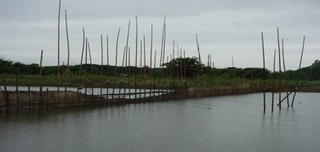On November 16th and 17th, I attended the Myanmar Fisheries and Aquaculture Research Symposium, organized conjointly by WorldFish and the Department of Fisheries (DoF) under the Myanmar Ministry of Agriculture, Livestock and Irrigation (MoALI) in Yangon. The objective of the symposium is to allow knowledge exchange on fisheries in Myanmar and to review past and present evidences in order to identify research gaps and opportunities in the sector. As part of the small-scale fisheries group sessions, I discussed a paper entitled 'Frictions between Fishing and Agriculture Interests: the case of the leasable fisheries in the Ayeyarwady Delta'.
The Delta of the Ayeyarwady (Irrawaddy) River has earned reputation as the rice bowl of Myanmar, a region where the interests of agriculture and rice cultivation have long been held as paramount, notably vis-à-vis those of fisheries. My presentation was concerned with the interactions between fishing and farming activities in the delta.
The delta is made up of various saucer-shaped islands, with land gently sloping from the riverbanks towards the "center" where creeks and wetlands drain southwards. During the monsoon periods, the rains fill the depressions in the interior. At the height of the flood in July-August, the whole plain resembles a vast expanse of water where various species of fish can breed and spawn. When water levels decrease in September-October, fish migrate to the deep waters of adjacent creeks and pools as they seek to make way to the river. These creeks and pools as well as the bodies of water left in the depressions after the receding of the flood waters constitute key fishing grounds known as in".
During Burmese times, in" fisheries were regarded as private properties and managed by traditional rural elites known as in"-tha"-kyi". After seizing Lower Burma and the delta region, the British made these productive fisheries state properties. A system of auction was introduced in the 1870s by which exclusive fishing rights were granted annually to the highest bidder. So-called leasable fisheries (in" ga-yan") are worked at the receding of the flood waters with a series of bamboo weirs. Then came a second period of fishing activities in January-March. During this period, the lessee or in"-tha"-kyi" has an exclusivity on all waters and fish contained in "his" fishery. This exclusivity and the lease ceases in April and follows a close season to allow species to renew.
With the expansion of rice cultivation, frictions between cultivators and fishers became more and more accute in the delta. Two main types of frictions can notably be observed nowadays:
1. When flood waters recede, cultivators seek to prepare their plots by draining the surplus water, including through the use of motorised pumps. In this case, the lessee in the adjoining fisheries may accuse the cultivators of seeking to stealing "their" fish. Indeed, fishery lessees traditionally claimed a right on any body of water (hence fish therein) connected to their main creek. Cultivators may agree with the fishers that he want the fish to compensate for the costs of drainage (i.e. fuel for pumping). In some cases, cultivators and fishers collaborate between themselves. The lessee of a fishery provide petrole to the cultivators in the adjoinings fields to drain the water and the fish in their direction. The fish that remains in the cultivators' field is then shared with the fishery lessee.
2. When harvesting summer paddy, around March-August, cultivators need irrigation water from the natural streams supporting fisheries. Around the same time, some fishers working remaining waters want to drain their fisheries by bailing. Both have to collaborate for the management of water.
Figure 1 - Configuration of Inn/farmland interaction in the Ayeyarwady Delta
Another source of friction between farming and fishing in the delta is that many creeks supporting fisheries are silting. Some villagers take advantage of this by reclaiming the silted fishery land and some even obtain temporary land use rights. When the land is flooded during the rains, the cultivators claimed that other villagers who depend on fisheries have no right to fish on "their" land. They argue that as having a right to the land, this also includes water. Since the enactement of the 2012 Farmland Law, cultivators can obtain Land Use Certificates (LUCs), which serve as land titles. This provides them with a permanent and exclusive annual right to the land (hence on water when the land is covered with water). The capture fishers who depend on an annual access to the fishing space are hence deprived from direct access to the flooded areas.

